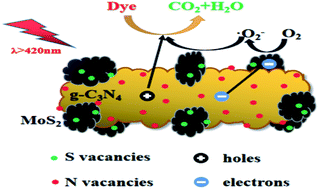g-C3N4/MoS2 composites were successfully prepared by an electron-assisted strategy in one step. Dielectric barrier discharge (DBD) plasma as an electron source, which has low bulk temperature and high electron energy, can etch and modify the surface of g-C3N4/MoS2. The abundant N and S vacancies were introduced in the composites by plasma. The dual defects promoted the recombination and formation of heterojunctions of the g-C3N4/MoS2 composite. It exhibited stronger light harvesting ability and higher charge separation efficiency than that of pure g-C3N4 and MoS2. Compared with the sample by traditional calcination method, the plasma-sample showed better performance for degrading rhodamine B (RhB) and methyl orange. RhB is completely degraded within 2 hours on g-C3N4/MoS2 by plasma. A mechanism for the photocatalytic degradation of organic pollutants via the composites was proposed. An electron-assisted strategy provides a green and effective platform to achieve catalysts with improved performance.

